Wayne Gillam
In the Neural Engineering Tech Studio, students participate in a competition aimed at developing their ideas into prototypes for commercial and clinical applications.
Armin Rouz’ mother has some visual impairments, and because of this she tends to lose things.
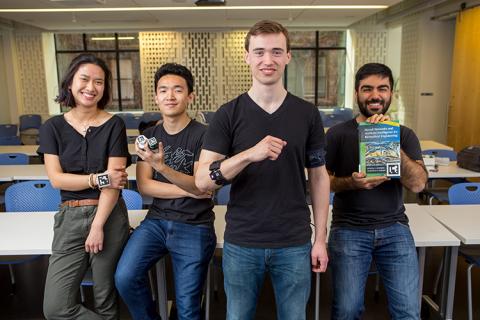
“She loses cases for her glasses a lot, backpacks, water bottles, purses,” Rouz said. “She tries to remember where she put things, and she usually gets to the place where she left stuff. But objects are not exactly where she remembers, and it’s hard for her to see what she lost.”
Rouz, a University of Washington (UW) undergraduate student majoring in bioengineering, is a participant in the UW’s Neural Engineering Tech Studio (BIOEN 461), a for-credit class originated and facilitated by the Center for Neurotechnology (CNT). Each spring, the class brings together teams of UW students in a friendly 10-week competition aimed at creating new, commercially viable neural engineering technologies that address real-world challenges like Rouz’ mother’s visual impairments.
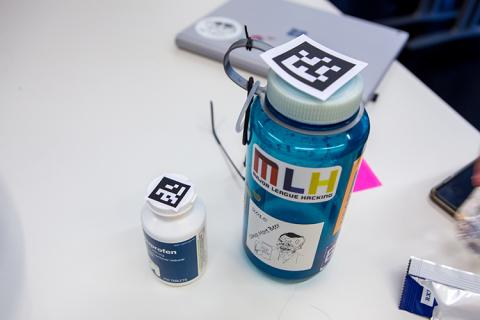
This year’s class is made up of five graduate students and 19 undergraduate students, divided into five teams. Each graduate student leads a team tasked with creating a novel concept using neural engineering technology that the team will then develop into a working prototype. In the class final presentations, teams demonstrate their prototypes in front of an audience and are judged by a panel of academic experts and industry leaders.
I haven’t taken any other course at the UW that gives you this kind of prototyping experience over such a short duration.
UW undergraduate student, Jacob Cadwell
The winning team receives seed money and incubation space in the CNT to help develop their invention, as well as guidance for preparing a product ready for the marketplace.
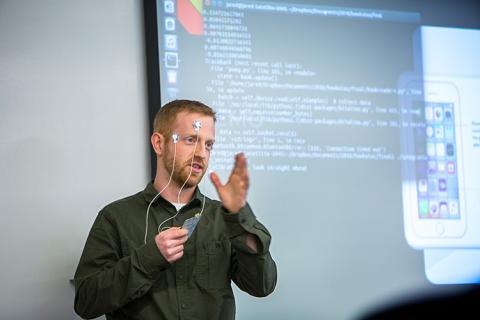
“The hope isn’t that they commercialize it right away, because it’s not likely to be ready for that yet,” said Lise Johnson, the class instructor and CNT university education manager. “We’d like to see them take it to the UW Business Plan Competition, or the Amazon Catalyst Competition or one of the many other entrepreneurial events around campus that would provide them with even more funding and support.”
Past winners of this UW class/competition, like the founders of MultiModal Health, have gone on to work with the CNT and UW CoMotion to develop their prototype, vHAB, into a viable product for the marketplace.
Hands-on experience engineering prototypes
According to several of the class participants, engineering students don’t always get the kind of fast-paced, hands-on experience that this class offers.
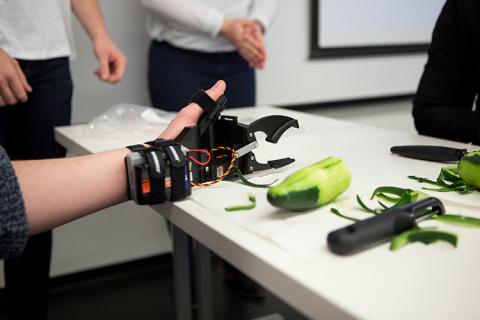
“Engineering students don’t receive many opportunities to go from start to end with a project,” said Mackenzie Andrews, a UW undergraduate student double-majoring in neurobiology and bioengineering. “We get a lot of theory and short lab projects and other activities, but we don’t get this unique experience of coming up with an idea as a group, designing it and prototyping. It has been really, really great.”
Jacob Cadwell, a UW undergraduate student studying mechanical engineering, expressed a similar thought. “If someone would like to get experience with hands-on prototyping, they should take this class. In a lot of other classes, you don’t actually get to build a physical product. You go through all of the stages to build it, and then you don’t [build it]. In this class, it’s almost instant…bam! You build something. I thought that was pretty cool. I haven’t taken any other course at the UW that gives you this kind of prototyping experience over such a short duration.”
The class requires that student teams narrow-down their ideas at the outset to those proposals with the greatest potential for positive human impact and commercial viability.
If you’re interested in neuroscience and hope to make a difference, this class can be a great creative outlet.
UW undergraduate student, Franklin Faust
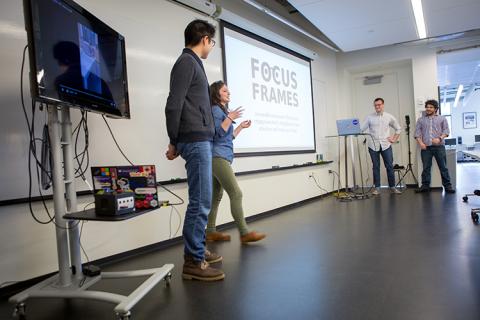
“The second week of the course, we had what we called the ‘Expert Round-Robin.’ We set it up kind of like speed dating, where student teams go around to each expert and do two or three idea pitches within a 15-minute timeframe,” Johnson said. “This year, we had CNT members, Eric Chudler, Eran Klein, Erik Rombokas, Josh Smith and Howard Chizeck. They listened to student’s pitches and helped them sort through the positives and negatives of each concept. I think the experts were impressed with the ideas the teams came up with and how thoughtful and creative the students were.”
After the teams each decided on an idea to pursue, they researched more thoroughly who the target and secondary markets for their project could be. They also began working through design iterations of their device/product with an eye on creating a working prototype for evaluation by academic experts and industry leaders at the end of the course.
“We’re not given instructions like, ‘This is how you do it,’ and told there’s a right way and a wrong way,” said Claire Mitchell, a UW undergraduate student studying bioengineering. “You kind of have to make it up as you go and find things online about how people previously attacked similar problems. You can then either use that, come up with something on your own or merge ideas.”
This is a competition
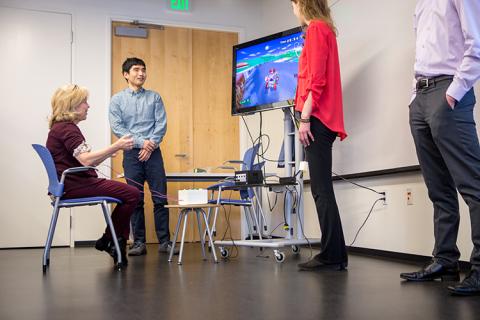
Rouz is a member of this year’s winning team, Os(eye)ris. His group created a wearable camera designed for visually-impaired individuals, like his mother, that assists in finding commonly used objects at home. Customized, printed fiducial markers are used to tag common items for identification at later times. When voice-activated by the user, the camera will turn on and sense objects tagged by these markers.
“You can say, ‘Hey, help me find my water bottle,’ and Os(eye)ris will search for the water bottle with the specific marker attached,” Rouz said. “It will give you an auditory beep or vibratory haptic feedback using a Myo™ band in order to help you move toward that object. A higher-frequency beep or haptic feedback means that you are closer to the object. It’s a way to help the user find things around their house that they might have trouble seeing.”
The class final presentations took place at the CNT on March 7, 2018, and this year’s judges were Terri Butler from the Beurk Center for Entrepreneurship, John Alleman from Cerevast Medical, Kim Emmons from the Washington Research Foundation, and Frederic Gilbert and Scott Ransom from the CNT.
“All the teams demonstrated a solid grasp of neural engineering applications, and they all had interesting ideas,” said Ransom, the CNT’s director of industry relations and innovation. “Os(eye)ris was ultimately chosen based on their robust technical design, business approach and application, and the fact that they had interviewed potential users and infused that feedback into their design.”

Other projects developed and demonstrated by student teams were:
• AEGIS: A plug-and-play alternative gaming controller that uses electromyography (EMG) signals for graded control, creating an intuitive and immersive gaming experience.
• Focus Frames: A wearable neurosensory device that detects engagement level, strengthens innate attention, and trains focus.
• Grasp Independence: An orthotic grasping mechanism for stroke survivors with hemiparesis who desire to perform independent tasks that require dual hand dexterity.
• Hawkulus: A wearable input modality for controlling a smartphone with eye movements, producing intuitive, hands-free device operation.
As students discover in the class, the path from a good idea to commercial success and clinical application can sometimes be long, but this course is helping to prepare them for that reality and teaching them how to navigate the challenges ahead. Plus, according to the students, it’s a lot of fun.
“If you’re interested in neuroscience and hope to make a difference, this class can be a great creative outlet,” said Franklin Faust, a UW undergraduate student studying neurobiology. “I hope that the CNT can continue to give students like myself this unique experience for many years to come.”
